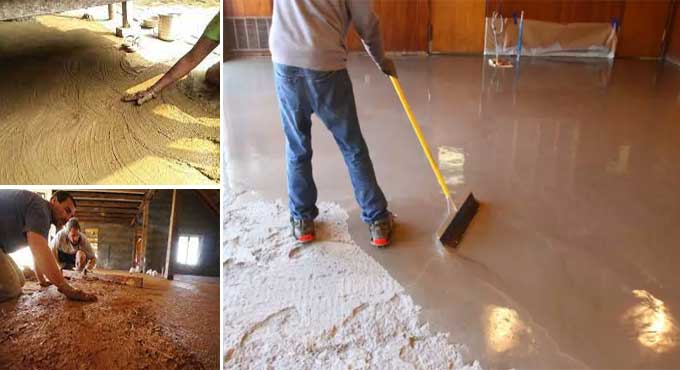
Mud Flooring: what you need to know

For years, people have utilized sustainable and conventional flooring made of mud. It is an excellent option for individuals searching for an eco-friendly substitute for contemporary flooring because it is very resilient, affordable, and green.
What are the benefits of Mud Flooring?
Comparing mud flooring to conventional concrete, wood, or tile floors reveals various benefits. It adds a distinctive style to any interior area while being economical and ecologically beneficial. Due to its toughness and longevity, mud flooring has been a mainstay in traditional and rural buildings for millennia in many regions of the world.
Mud floors have the benefit of regulating and absorbing moisture. In addition to being easy to install and maintain, mud flooring is very durable. The application of mud flooring is quick and easy, unlike most traditional flooring materials, and requires little maintenance.
Mud flooring, in contrast to conventional flooring materials, is highly resilient and, with appropriate maintenance, may last for decades. It is also inherently resistant to dents, scratches, and other types of harm.
It is a great choice for any home to have mud flooring. A unique and rustic aesthetic can be achieved with this type of flooring because it is affordable, durable, and easy to maintain. Humidity-prone areas benefit from their ability to regulate and absorb moisture.
How to install a Mud Floor?
The major steps for installing a mud floor are as follows:
1. First Prepare the Subfloor - Subfloors must be level and flat before mud floors can be installed. If necessary, use a floor sander to smooth out the subfloor if any loose debris, carpet, or other materials are present.
2. Make the mud mixture - To create the mud flooring, sand, clay, and straw should be combined. Both a power mixer and human labour are acceptable for this. Depending on the type of plywood being used and the desired consistency of the mud flooring, the amount of sand and clay will vary.
3. Apply the mud - A trowel or squeegee should be used to spread the mud mixture evenly over the subfloor. The mud should be spread properly and smoothed out with a floor roller after it has been rolled and smoothed out. Allow the mud to dry completely once it has been applied to the entire area.
4. Add required finishing touches - It is now time to apply the finish to the mud flooring once it has dried. Depending on your preference, this could be a sealer, wax, or another finish. Before applying the finish, the mud floor must be completely dry. It is important to allow the finish to completely dry before walking on the floor after it has been applied.
How to maintain a Mud Floor?
A beautiful and adaptable alternative for a variety of home and business settings is mud flooring. Its distinctive qualities give it a natural appearance, feel, durability, and strength. To guarantee your mud flooring's enduring beauty and effectiveness, it is crucial to keep it well-maintained.
The degree of moisture exposure to mud flooring is the key element impacting upkeep. Mud flooring can grow soft and more vulnerable to harm when exposed to a lot of moisture. Making ensuring the space is well-ventilated and dry is crucial before installing the mud flooring. To further preserve your mud flooring from moisture, it may be beneficial to seal it or cover it with polyurethane.
Maintaining mud flooring requires regular cleaning as well. A soft-bristled broom or vacuum should be used regularly to sweep up dust and dirt. Heavy dirt and grease stains can be removed with a wet mop and a gentle pH-neutral cleaner. The finish of the mud flooring may be damaged by harsh cleaners.
It is crucial to routinely inspect your dirt flooring for any damage or telltale indications of wear. If any damage is discovered, it is essential to seek expert advice or get it fixed right away. Deep gouges or cracks may require the entire damaged area to be replaced in order to maintain the floor's structure and integrity.
Varieties of Mud Flooring
Clay Flooring
Traditional and rustic-style homes typically use clay flooring as one of the most common types of mud flooring. It's made by mixing clay with sand and water, a combination of minerals such as silica, alumina, iron oxide, and others.
Stone Flooring
Normally, stone flooring is constructed from specially cut stones laid in a pattern and sealed with a binding agent. Patios and porches are popular outdoor areas for this material since it is durable and wear-resistant. The installation of stone flooring requires a lot of labour and careful attention. The material is also low maintenance and is ideal for traditional and contemporary homes.
Dirt Flooring
Creating a solid surface from dirt and binding material is called dirt flooring. It is usually sand or lime that is used to bind the dirt. It is a popular choice for rustic, earthy-styled homes to have dirt flooring. The cost of installation is relatively low, and it is easy to maintain as well.
To learn more, watch the following video tutorial.
Video Source: Sourabh Phadke
Adobe Flooring
A beautiful and long-lasting alternative, adobe flooring has been used for generations. Classic material for flooring is a mix of clay, sand, and straw. Any house may benefit from adobe flooring's distinctive appearance, which is also noted for being durable and simple to maintain.
It is often found in traditional home decor and is an affordable option. In addition to brown shades and reddish tones, it is often made in a variety of colours. Moreover, the flooring can be fitted to any room due to its wide variety of sizes and shapes.


